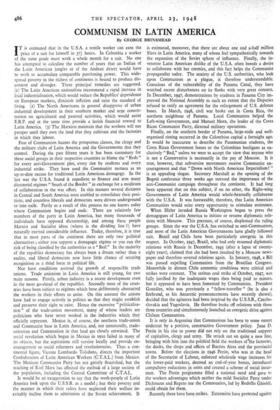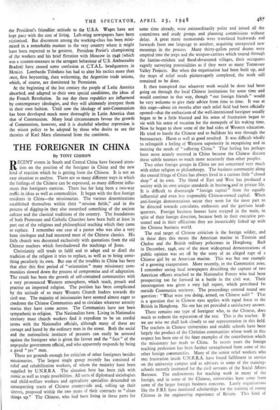COMMUNISM IN LATIN AMERICA
By GEORGE BRINSMEAD TT is estimated that in the U.S.A. a textile worker can earn the 1 price of a suit for himself in 371 hours. In Colombia a worker of the same grade must work a whole month for a suit. No one has attempted to calculate the number of years that an Indian of the Latin American jungles or of the Andean desert would have to work to accumulate comparable purchasing power. This wide- spread poverty in the richest of continents is bound to produce dis- content and disorcler. Three principal remedies are suggested. (i) The Latin American nationalists recommend a rapid increase in local industrialisation, which would reduce the Republics' dependence on European markets, diminish inflation and raise the standard of living. (a) The North Americans in general disapprove of urban industrial development in their southern market and urge concen- tration on agricultural and pastoral activities, which would assist E.R.P. and at the same time provide a lavish financial reward to Latin America. (3) The Marxists maintain that the workers will not prosper until they own the land that they cultivate and the factories in which they labour.
Fear of Communism haunts the prosperous classes, the clergy and the military clubs of Latin America and the Governments that they control. During the past fifteen years it has been customary for these social groups in their respective countries to blame the "Reds " for every anti-Government plot, every riot by students and every industrial strike. They have used the Communist menace as an up-to-date excuse for traditional Latin American demagogy. In the last war the U.S.A. found it expedient to finance and arm many dictatorial regimes -" South of the Border " in exchange for a modicum of collaboration in the war effort. In this manner several dictators in Central and South America were enabled to consolidate their posi- tions, and countless liberals and democrats were driven underground or into exile. Partly as a result of this process no one knows today where Communism begins and ends: There are relatively few members of the party in Latin America, but many thousands of individuals have opposed dictatorship, and among these people Marxist and Socialist ideas (where is the dividing line ?) have naturally exerted considerable influence. Today, therefore, it is true that in most parts of the continent there are only two political alternatives ; either you support a demagogic regime or you run the risk of being classified by the authorities as a " Red." In the majority of the republics democracy has always been a dream rather than a reality, and liberal democrats now have little chance of securing recognition as a third force in political life.
Nor have conditions assisted the growth of responsible trade unions. Trade unionism in Latin America is still young, for two main reasons. Firstly, urban industry is a recent development even in the most go-ahead of the republics. Secondly most of the coun- tries have been subject to regimes which have deliberately obstructed the workers in their efforts to unite. On this account the unions have had to engage actively in politics so that they might establish and preserve their right to exist. Hence the excessive " politicalisa- tion " of the trade-union movement, many of whose leaders are politicians who have never worked in the industries which they officially represent. Mexico is, of course, the northern trade-union and Communist base in Latin America, and, not unnaturally, trade- unionism and Communism in that land are closely entwined. The social revolution which began in Mexico in 1910 failed in many of its objects, but the aspirations still survive locally and provide en- couragement to social reformers and revolutionaries. Thus a con- tinental figure, Vicente Lombardo Toledano, directs the important Confederation of Latin American Workers (C.T.A.L.) from Mexico. The Mexican Communist Party has not greatly flourished, but the teaching of Karl Marx has affected the outlook of a large section of the population, including the Central Committee of C.T.A.L.
It would be an exaggeration to say that the work-people of Latin America look upon the U.S.S.R. as a model ; but their poverty and the manner in which their rulers have neglected their welfare in- evitably incline them to admiration of the Soviet achievement. It is estimated, moreover, that there are about one and a-half million Slays in Latin America, many of whom feel 'sympathetically towards
the expansion of the Soviet sphere of influence. Finally, the, in-
veterate Latin American dislike of the U.S.A. often breeds a desire to collaborate with her enemies, and this fact helps the Communist propagandist today. The anxiety of the U.S. authorities, who look upon Communism as a plague, is therefore understandable. Conscious of the vulnerability of the Panama Canal, they have watched recent disturbances on its flanks with very great concern. In December, 1947, demonstrations by students in Panama City im- pressed the National Assembly to such an extent that the Deputies refused to ratify an agreement for the enlargement of U.S. defence bases. In March, 1948; civil war broke out in Costa Rica, the northern neighbour of Panama. Local Communists helped the Left-wing Government, and Manuel Mora, the leader of the Costa Rican Communist Party, directed military operations.
Finally, on the southern border of Panama, large-scale and well- organised rioting occurred in the Colombian capital a fortnight ago. It would be inaccurate to describe the Panamanian students, the Costa Rican Government forces or the Colombian hooligans as ex- clusively " Red," unless we were to accept the view that anyone who is not a Conservative is necessarily in the pay of Moscow. It is true, however, that subversive movements receive Communist en- couragement and that "Down with North American Imperialism! " is an appealing slogan. Secretary Marshall at the opening of the Bogota conference three weeks ago stressed the importance of the anti-Communist campaign throughout the continent. It had long been apparent that on this subject, if on no other, the Right-wing Governments of Latin America would whole-heartedly collaborate with the U.S.A. It was foreseeable, therefore, that Latin American Communists would seize every opportunity to stimulate resistance.
When Hitler invaded Russia Washington began to press the demagogues of Latin America to initiate or resume diplomatic rela- tions with Moscow. This pressure, of course, displeased the ruling groups. Since the war the U.S.A. has switched to anti-Communism, and most of the Latin American Governments have gladly followed suit. Brazil and Chile have been particularly energetic in this respect. In October, 1947, Brazil, who had only resumed diplomatic relations with Russia in December, 1945 (after a lapse of twenty- eight years), claimed that she had been insulted by a Moscow news- paper and therefore severed relations again. In January, 1948, a Bill was passed expelling Communists from the Brazilian Congress. Meanwhile in distant Chile economic conditions were critical and strikes were constant. The serious coal strike of October, 1947, was fully justified by the inadequate wages then being paid to miners, but it appeared to have been fomented by Communists. President Gonzalez, who was previously a " fellow-traveller " (he is also a firebrand, as his Antarctic pronouncements have recently shown), decided that the agitators had been inspired by the U.S.S.R., Czecho- slovakia and Yugoslavia. He therefore broke off relations with those three countries and simultaneously launched an energetic drive against Chilean Communists.
It is only in Argentina that Communism has been to some extent undercut by a poSitive, constructive Government policy. Juan D. Per6n in his rise to power did not rely on the traditional support of capitalists, clergy and army. 'He struck out on quite a new line, bringing with him into the political field the workers of*the factories, the docks, the shops and offices of Buenos Aires and the provincial towns. Before the elections in 1946 Peron; who was at the head of the Secretariat of Labour, enforced wholesale wage increases for the lower-paid workers, decreed an end-of-year bonus, introduced compulsory reductions in rents and created a scheme of social insur- ance. The Peron programme filled a national need and gave to the workers advantages which neither the mild Socialist Party under Dickman and Repeto nor the Communists, led by Rodolfo Ghioldi, could obtain for them.
Recently there have been strikes. Extremists have protested against
the President's friendlier attitude to the U.S.A. Wages have not kept pace with the cost of living. Left-wing newspapers have been victimised. But discontent among the working-class has been mini- mised in a remarkable manner in the very country where it might have been expected to be greatest. President Peron's championing of the workers and his brief flirtation with Moscow in 1946 (which was a counter-measure to the arrogant behaviour of U.S. Ambassador Braden) have caused some confusion at C.T.A.L. headquarters in Mexico. Lombardo Toledano has had to alter his tactics more than once, first boycotting, then welcoming, the Argentine • trade unions, which, of course, are dominated by Peronistas.
At the beginning of the last century the people of Latin America absorbed, and adapted to •their own special conditions, the ideas of the French Revolution. In our day these republics are influenced by contemporary ideologies, and they will ultimately interpret them in their own fashion. Until now the ideology of anti-Communism has been developed much more thoroughly in Latin America than that of Communism. Many local circumstances favour the growth of Communism, however, and it is doubtful whether repression is the wisest policy to be adopted by those who desire to see the theories of Karl Marx eliminated from the continent.



































 Previous page
Previous page